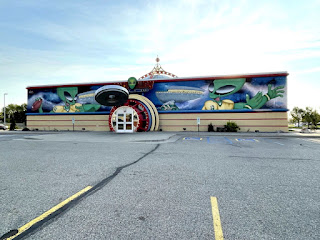Located at the Hjemkomst Center in Moorhead, Minnesota, is a replica of the historic Norwegian Hopperstad Stave Church in Vikoyri, Vik Municipality, Vestland. The church is one of the oldest stave churches still standing in Norway and is believed to have been built in about 1130.
The Hjemkomst Center and Stave Church replica opened in 1985, along with a museum and replica of the Gokstad Viking ship that was discovered in Norway in 1880. Hjemkomst means "Homecoming" in Norwegian.
Not too far from the stave church is the World's Largest Dilly Bar that is located beside a Dairy Queen (DQ) store.
The first DQ opened in Joliet, Illinois, in 1940, but this is the location where the Dilly Bar was invented in 1955. To commemorate the invention, DQ erected a 12-foot tall Dilly Bar on the site. Even local cows stop at this location for their soft serve treats. (DQ does not use the term "ice cream" because FDA requires "ice cream" to have a minimum of 10% butterfat content and DQ's soft serve only contains 5% butterfat.)
I knew that I was in Fargo, North Dakota, when I drove across the river and encountered "Space Aliens." I really wish I could have timed my trip to visit the Grill & Bar at night when it was open. I left "Space Aliens" on my bucket list for a revisit.
Located in downtown Fargo is the famous "Sodbuster: San Isidro" statue that is part of the Plains Art Museum Permanent Collection. A placard by the statue states: "The term 'Sodbuster' is a colloquialism for farmers and 'San Isidro' refers to the Catholic patron saint of farmers." Unfortunately, the sun was just coming up and my camera did not capture the spectacular colors in this exhibit.
As I was leaving Fargo, I stopped by an industrial park to see a building that was made with the "World's Longest Piece of Seamless Steel Siding." The 236-feet long single piece of siding was listed in the Guinness Book of World Record on November 9, 1999.
Located along the west side of the Bois de Sioux River in Wahpeton (population 8,007), North Dakota, is the World's Largest Catfish, known as "The Wahpper." The fish is 40-feet long and weighs over 5,000 pounds.
Breckenridge (population 3,430), Minnesota, is located directly across the Bois de Sioux River from Wahpeton, North Dakota. For golfers, the Bois de Sioux Public Golf Course is the only golf course in the United States that is located in two different states - North Dakota and Minnesota.
There is a nice veterans park in Breckenridge and as I was taking a picture of the railroad deport, I had to move off of the track because a RRV&W train came by the station.
Located at the junctions of Big Chief Road, County Road 82 NW, and Interstate 94, about 5 miles south of Fergus Falls, there is a picnic shelter with exhibits. A large statue of a survey instrument marks the spot that what was once thought to be on a Continental Divide, but more recent equipment has determined that the earlier Continental Divide measurements were incorrect. On the web it states that this general area is the approximate geological divide between the forest of the Northwest Territories and the great plains to the west.
There were no placards at the small park to describe the exhibits, but located by the picnic shelter were a buffalo statue and the framework for an Indian teepee.
Grotto Park in Fergus Falls (population 14,119) is a known location for observing migratory birds. When I stopped at the park, there were a number of different birds on the lake and in the air, while Canadian Geese walked around the grass looking for food.
This area of Minnesota was impacted by Ice Age glaciers and as the glaciers melted they left numerous lakes and small streams and rivers.
Fergus Falls is the seat of Otter Tail County. To commemorate the large numbers of otters that once lived in the area, located in the park's play area is "Otto," the "World's Largest Otter" Statue. "Otto" is 40-feet long and 15-feet tall.
A short distance from Otto, is a nice veterans memorial.When I drove into Battle Lake (population 857), I noticed several historic grain elevators that were in good condition and still appeared to be in use. I try to photograph historic grain elevators when I see them because they may not be around much longer.
The town of Battle Lake received its name from a battle between the Dakota and Ojibwe Indian tribes. In 1795, Chief Wenonga led a band of 50 Ojibwe warriors into battle against the Dakota Indians at this site and only a few of the Ojibwe warriors survived.
Wenonga was one of the survivors, but all of the Dakota Indians were killed. After the battle, the lake was named Ish-quan-a-de-win-ing, which means "Where but few survived." When settlers moved into the area, they could not remember the lake's Indian name, so they renamed the site Battle Lake. Located on the west edge of the lake is a statue of Chief Wenonga that is 23-feet tall.
Located in downtown Battle Lake is a pedestrian alley called "Art Stream." There are large metal fish marking the alley entrance and exit and along the alley there are wall murals. The alley pavement is decorated with aquatic-life outlines and people are encouraged to color the figures using colored chalk.








































No comments:
Post a Comment